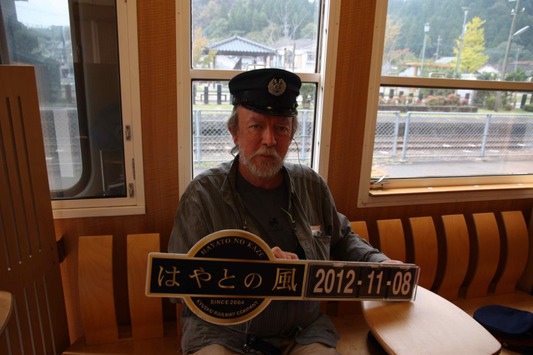Thursday, 8 November 2012

At least three times during the night I lay half asleep trying to figure out what that noise was. It certainly sounded like rain, a possibility I dismissed as absurd first time around, but when it reappeared, with the sound of some sort of emergency vehicle passing by, siren engaged, I considered the possibility a little further.
We're on the thirteenth floor (out of fourteen) and on a corner of a rectangular building, so perhaps rain, driven by a strong wind might account for it. Trouble was, there was no sound of wind.
On the third, or possibly fourth or fifth occasion the penny dropped. It was the air conditioner.
On other days with walking around as a significant part of the agenda, but given the morning's schedule, a rail based loop through southern Kyushu that was going to involve some pretty smart movement given an interval of three minutes between trains at the last changeover, rain wasn't likely to be too much of an issue.
Of course, we needed to get to the station, but with two nights in the same location the Little Red Travelling Bag would be safe and sound in the Sunn Days Inn, Kagoshima.
The loop should bring us back into Kagoshima around a quarter to one, giving us the afternoon and most of the following morning to take a look around the city that has been tagged the Naples of the Eastern world.
A prime bayside location, an impressive stratovolcano (Sakurajima, Kagoshima's equivalent of Vesuvius) and a mild climate that’s largely related to a position as Kyushu's southernmost major city combine to deliver that moniker. It’s the capital of the local prefecture and its largest city by a fair distance.
Right on the southern tip of Kyushu, Kagoshima Prefecture stretches around six hundred kilometres, as far as the boundary with the neighbouring Okinawa Prefecture in the Ryūkyū Islands and includes Yakushima Island, a UNESCO World Natural Heritage Site, the twelve Tokara Islands and Amamioshima, the second largest isolated island in Japan.
Dating back to the fourteenth century. Kagoshima sits on the northeastern Satsuma peninsula, facing Kagoshima Bay (also known as Kinko Bay). As the political and commercial centre of territory controlled by the Shimazu clan of samurai through medieval times and into the Edo period (1603–1867) when it became the capital of the Satsuma Domain.
Satsuma was one of the wealthiest and most powerful fiefdoms, and though international trade was banned for much of the seventeenth and eighteenth centuries, the city remained prosperous. It also served as the political centre for the semi-independent vassal kingdom of Ryūkyū, whose traders and emissaries frequented the city. Kagoshima had also been a significant centre of Christian activity before the religion was banned in the late sixteenth century.